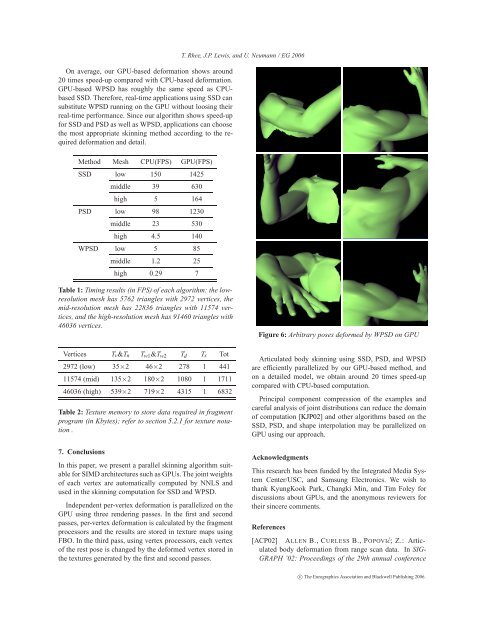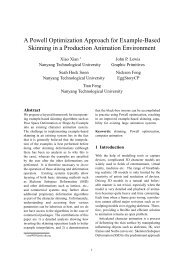Real-Time Weighted Pose-Space Deformation on the GPU
Real-Time Weighted Pose-Space Deformation on the GPU
Real-Time Weighted Pose-Space Deformation on the GPU
You also want an ePaper? Increase the reach of your titles
YUMPU automatically turns print PDFs into web optimized ePapers that Google loves.
On average, our <strong>GPU</strong>-based deformati<strong>on</strong> shows around<br />
20 times speed-up compared with CPU-based deformati<strong>on</strong>.<br />
<strong>GPU</strong>-based WPSD has roughly <strong>the</strong> same speed as CPUbased<br />
SSD. Therefore, real-time applicati<strong>on</strong>s using SSD can<br />
substitute WPSD running <strong>on</strong> <strong>the</strong> <strong>GPU</strong> without loosing <strong>the</strong>ir<br />
real-time performance. Since our algorithm shows speed-up<br />
for SSD and PSD as well as WPSD, applicati<strong>on</strong>s can choose<br />
<strong>the</strong> most appropriate skinning method according to <strong>the</strong> required<br />
deformati<strong>on</strong> and detail.<br />
Method Mesh CPU(FPS) <strong>GPU</strong>(FPS)<br />
SSD low 150 1425<br />
middle 39 630<br />
high 5 164<br />
PSD low 98 1230<br />
middle 23 530<br />
high 4.5 140<br />
WPSD low 5 85<br />
middle 1.2 25<br />
high 0.29 7<br />
T. Rhee, J.P. Lewis, and U. Neumann / EG 2006<br />
Table 1: Timing results (in FPS) of each algorithm: <strong>the</strong> lowresoluti<strong>on</strong><br />
mesh has 5762 triangles with 2972 vertices, <strong>the</strong><br />
mid-resoluti<strong>on</strong> mesh has 22836 triangles with 11574 vertices,<br />
and <strong>the</strong> high-resoluti<strong>on</strong> mesh has 91460 triangles with<br />
46036 vertices.<br />
Vertices T v&T n T w1 &T w2 T d T x Tot<br />
2972 (low) 35×2 46×2 278 1 441<br />
11574 (mid) 135×2 180×2 1080 1 1711<br />
46036 (high) 539×2 719×2 4315 1 6832<br />
Table 2: Texture memory to store data required in fragment<br />
program (in Kbytes); refer to secti<strong>on</strong> 5.2.1 for texture notati<strong>on</strong><br />
.<br />
7. C<strong>on</strong>clusi<strong>on</strong>s<br />
In this paper, we present a parallel skinning algorithm suitable<br />
for SIMD architectures such as <strong>GPU</strong>s. The joint weights<br />
of each vertex are automatically computed by NNLS and<br />
used in <strong>the</strong> skinning computati<strong>on</strong> for SSD and WPSD.<br />
Independent per-vertex deformati<strong>on</strong> is parallelized <strong>on</strong> <strong>the</strong><br />
<strong>GPU</strong> using three rendering passes. In <strong>the</strong> first and sec<strong>on</strong>d<br />
passes, per-vertex deformati<strong>on</strong> is calculated by <strong>the</strong> fragment<br />
processors and <strong>the</strong> results are stored in texture maps using<br />
FBO. In <strong>the</strong> third pass, using vertex processors, each vertex<br />
of <strong>the</strong> rest pose is changed by <strong>the</strong> deformed vertex stored in<br />
<strong>the</strong> textures generated by <strong>the</strong> first and sec<strong>on</strong>d passes.<br />
Figure 6: Arbitrary poses deformed by WPSD <strong>on</strong> <strong>GPU</strong><br />
Articulated body skinning using SSD, PSD, and WPSD<br />
are efficiently parallelized by our <strong>GPU</strong>-based method, and<br />
<strong>on</strong> a detailed model, we obtain around 20 times speed-up<br />
compared with CPU-based computati<strong>on</strong>.<br />
Principal comp<strong>on</strong>ent compressi<strong>on</strong> of <strong>the</strong> examples and<br />
careful analysis of joint distributi<strong>on</strong>s can reduce <strong>the</strong> domain<br />
of computati<strong>on</strong> [KJP02] and o<strong>the</strong>r algorithms based <strong>on</strong> <strong>the</strong><br />
SSD, PSD, and shape interpolati<strong>on</strong> may be parallelized <strong>on</strong><br />
<strong>GPU</strong> using our approach.<br />
Acknowledgments<br />
This research has been funded by <strong>the</strong> Integrated Media System<br />
Center/USC, and Samsung Electr<strong>on</strong>ics. We wish to<br />
thank KyungKook Park, Changki Min, and Tim Foley for<br />
discussi<strong>on</strong>s about <strong>GPU</strong>s, and <strong>the</strong> an<strong>on</strong>ymous reviewers for<br />
<strong>the</strong>ir sincere comments.<br />
References<br />
[ACP02] ALLEN B., CURLESS B., POPOVIć; Z.: Articulated<br />
body deformati<strong>on</strong> from range scan data. In SIG-<br />
GRAPH ’02: Proceedings of <strong>the</strong> 29th annual c<strong>on</strong>ference<br />
c○ The Eurographics Associati<strong>on</strong> and Blackwell Publishing 2006.







